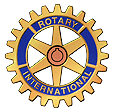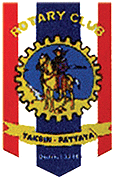- HEADLINES [click on headline to view story]:
-
PCEC members experience miracles in the sky
-
Rotarians in Sattahip, donate wheelchairs, canes to disabled
|
|
PCEC members experience miracles in the sky
Master of Ceremonies Richard Silverberg welcomed everyone
to the Pattaya City Expat Club meeting at Henry J Beans on Sunday, January
24 and after the usual announcements, he introduced the guest speaker, Roger
Fox. Roger, a helicopter pilot during the Vietnam War, said his presentation
would be about Miracles in the Sky. He said that flying is imminently safe,
but when an accident happens, especially with an airliner, they tend to be
catastrophic and attract a lot of publicity.
Roger said that there are basically three reasons flying on an airliner
today is very safe. First, there are exacting government requirements for
the building and testing of new airplanes that must be met before they will
be certified as air worthy. After they are placed in service, there are
scheduled inspection and maintenance requirements that must be met. These
requirements are designed to ensure parts are repaired or replaced before
they can fail.
 The
mid air collision was caused when one plane came out of a cloud, and the
pilot was disoriented by atmospheric turbulence - in attempting to avoid a
collision, a collision resulted. The 707 landed safely, but the
Constellation crash landed in a field - fortunately all but 4 were saved. The
mid air collision was caused when one plane came out of a cloud, and the
pilot was disoriented by atmospheric turbulence - in attempting to avoid a
collision, a collision resulted. The 707 landed safely, but the
Constellation crash landed in a field - fortunately all but 4 were saved.
Second, there are also rigorous requirements for airline pilots. They must
have a periodic flight physical and they must undergo regular check rides
with a check pilot observing their every move to ensure they maintain their
proficiency.
The third reason is that airliners are under constant positive control from
the ground. These ground controllers, through the use of radar and other
means, monitor the aircraft continually. But, he said, even with all of
these precautions, “stuff” happens. This is usually because of natural
disaster, pilot error, or mechanical failure. He opined that probably 80
percent of airline accidents could be attributed to pilot error. Although
there were several interesting events to draw on, Roger said he selected
three events, one in each category, that he thought were extraordinary.
The first was a British Airways Boeing 747 flying from Heathrow to Auckland.
On the leg from Kuala Lumpur to Perth, the crew was flying at night and
first noted an effect on their windscreen similar to St Elmo’s fire.
Suddenly, they lost one engine and then rapidly lost the other three. The
crew then started a long glide with the hope they might make Jakarta. The
pilot gave the following message to the passengers, considered as a
masterpiece of understatement, “Ladies and Gentlemen, this is your Captain
speaking. We have a small problem. All four engines have stopped. We are
doing our damnedest to get it under control. I trust you are not in too much
distress.”
The crew continued to try to restart the engines even though they were below
the recommended altitude for doing so. But they did manage to restart one
engine and a bit later the other three. After landing in Jakarta, it was
discovered that when they were at about 36,000 feet, they had flown through
ash thrown up by an erupting volcano. Roger noted that a group of passengers
from that flight still meet periodically to celebrate their survival.
The second incident involved a DC-10 flying from Denver to Chicago in the
USA. Roger explained that modern airliners have to use hydraulic pressure to
operate the flight controls. The DC-10 was equipped with a main hydraulic
system and two backup systems. Using a picture, he pointed out the
aircraft’s three engines with the number two engine in the center of the
tail section. He said that during flight, this engine blew up and severed
lines from all three hydraulic systems. Thus, the crew lost all flight
controls. But, they discovered they had some control by changing the thrust
of the two remaining engines; it was poor control at best as they could only
make wide circular turns.
Roger showed a diagram of the circular flight pattern they flew to
eventually get the aircraft to the Sioux City airport. But, they were coming
in with too high a rate of descent and much too fast. A wing hit the ground
and the aircraft crashed. But, because the crew had got it over the
threshold of the airport, there was help immediately available and 185 of
the 296 aboard survived.
The third incident Roger referred to as a prequel to the miracle on the
Hudson. This incident involved a Boeing 707 jet and a Lockheed Constellation
(piston engine) that had a mid-air collision over New York. Roger explained
how the two aircraft were actually at different altitudes about 1,000 feet
apart, but to the Constellation pilot, it appeared they were on a collision
course. The pilot then made a maneuver that actually did cause a collision.
With the aid of two model aircraft, Roger demonstrated how the two aircraft
were positioned and how the wrong maneuver resulted in the midair collision.
The 707 with a portion of its wing missing managed to make it to John F.
Kennedy airport. However, the Constellation could not make an airport and
the pilot opted to crash land the aircraft in a pasture on the side of a
hill. The pilot maneuvered the aircraft so that it pancaked into the hill
upon landing. The aircraft broke into three pieces, but most of the
passengers survived.
Roger noted that the crew survived the crash and assisted the passengers in
getting out. But, he said, the pilot went back inside for the last
passenger. That was where his and the passenger’s bodies were found. Two
other passengers died later of their injuries.
In conclusion, Roger pointed out that each of these events has contributed
to the training of other pilots so that flying can continue to be safe. He
then opened it up for questions and to everyone’s surprise, a member of the
audience said that he was a passenger on the British Airways flight and
confirmed that several of the passengers do in fact meet every five years to
celebrate their survival.
Richard Silverberg then updated everyone on upcoming events and called on
Harry “Sig” Sigworth to conduct the always informative Open Forum where
everyone has an opportunity to ask and answer questions about living in
Thailand and Pattaya in particular.
Rotarians in Sattahip, donate
wheelchairs, canes to disabled

President Amorn Singh Kwatra
together with Rotarians and government officials presented wheelchairs, canes
and leg braces to 14 disabled people.
Patcharapol Panrak
The Rotary Club of Sattahip, in conjunction with the local government, donated
wheelchairs, canes and leg braces to 14 disabled people in the area.
Sattahip Mayor Narong Bunbancherdsri together with Amorn Singh Kwatra, President
of the Rotary Club of Sattahip presented the seven chairs, six canes and braces
to residents at the Sattahip Municipal Office on January 19.
Narong said he contacted the Rotary Club for help after he learned of the
residents who were too poor to afford the devices they needed to get around.
President Amorn said it was part of the Rotary club’s continuing effort to work
together with the government sector to ensure a good quality of life for people
with disabilities.
|
|

News | Business | Features |
Columns | Mail Bag |
Sports | Auto Mania
Our Children | Travel |
Our Community | Dining Out & Entertainment
Social Scene | Classifieds |
Community Happenings | Books Music Movies
Clubs in Pattaya | Sports Round-Up
E-mail: [email protected]
Pattaya Mail Publishing Co.Ltd.
62/284-286 Thepprasit Road, (Between Soi 6 & 8) Moo 12, Pattaya City
T. Nongprue, A. Banglamung,
Chonburi 20150 Thailand
Tel.66-38 411 240-1, 413 240-1, Fax:66-38 427 596
Copyright © 2004 Pattaya Mail. All rights reserved.
This material may not be published, broadcast, rewritten, or redistributed.

|
|

Rotary
International

www.rotary-jomtien.org

www.rotary-taksin.org

|